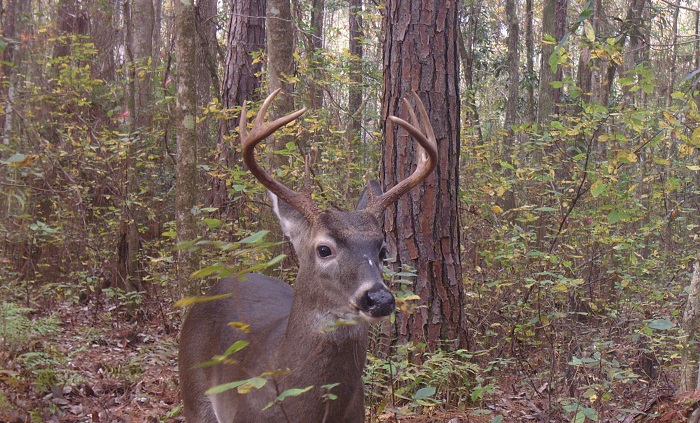
by Jennifer Bearden | Oct 31, 2015
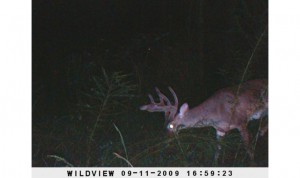
Deer in velvet. Photo by Jennifer Bearden
When hunting, food safety begins in the field. The goal is to have safe meat for you and your family to eat. Here are a few ways to keep your food safe:
- Shot placement – that’s right. Food safety begins with an accurate shot. Your goal should be to prevent the contents of the digestive tract from touching the meat. A gut shot can quickly ruin meat and make cleaning the animal harder.
- The quicker you get the meat chilled the better. Improper temperature is meat’s number one enemy. The recommended storage temperature to prevent bacterial growth is 35-40°F.
- Handle the knife with one hand and the carcass with the other. The hide can harbor dirt and pathogens so care should be taken to prevent contamination of the meat.
- Have vinegar water and chlorine water on hand. Vinegar water (50/50) can be sprayed on areas where hair or hide touch the meat. Rinse hands and tools periodically in a bucket of sanitizing solution of 1 tbsp of chlorine per gallon of water.
- Think food safety through the whole process. Prevent cross contamination by keeping anything from contacting the meat unless it has been sterilized. Keep the digestive tract intact and prevent the contents of it from contacting the meat. Chill the meat as quickly as possible. When further processing, continue to use sterile surfaces and tools.
For more information on wild game processing safety, you can attend our upcoming Wild About Deer: Game Processing Program on November 14 from 10am to 2pm. We will teach processing safety from field to table. A home-cooked venison meal will be provided. The cost is $20. Please pre-register by calling 850-689-5850.
Wild about Deer Flyer
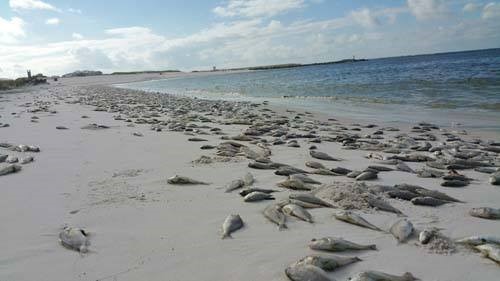
by Rick O'Connor | Oct 31, 2015
Many coastal Panhandlers woke up this week to the sight and smell of dead fish. Thousands of them washed ashore from Panama City to Pensacola. This mass die off included a variety of species including whiting, sheepshead, hake, cusk eels, and even lionfish; there were also reports of dead bass from the Dune Lakes in Walton and Okaloosa counties. What caused this mass die off of fish?
The suspect is red tide…
Most of us along the panhandle have heard of red tide but we may not know what it is or what causes it. Many attribute the red tide events to human impacts, stormwater runoff etc., but in fact they have been around for centuries. There are records suggesting that the European colonials experienced them and I have read one account that the Red Sea got its name from the frequency of these events there. So what is this “red tide” and what causes it?
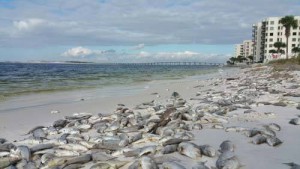
Dead fish line the beaches of Panama City.
Photo: Randy Robinson
It is actually a bloom of small single celled plants called dinoflagellates. There are thousands of species of dinoflagellates in the world’s oceans and not all cause red tide, but there are several species that do. These small microscopic plants drift near the surface of the ocean acquiring sunlight to photosynthesize. They possess two small “hairs” called flagella (hence the name “dinoflagellate”) to help orient themselves in the water column. Most have a shell covering their body called a theca and some shells have small spines to increase their surface area to resist sinking. One method of defense found in some dinoflagellates is the production of light – bioluminescence. This light is produced by a chemical reaction triggered by the creature as a flash of blue – many locals refer to it as “phosphorus”. Other dinoflagellates instead will release a toxin… some of these are ones we call “red tide”.
Red tide organisms are always in the water column of marine environments but are usually in low concentrations, maybe 300-500 cells per milliliter of water. But under favorable conditions, warm water with nutrients, they multiple… sometimes in great numbers, such as 3000-5000 cells/ml, and we have a “bloom”. The number of cells within these blooms can be high enough that we can actually see the water change color… hence “red tide”.
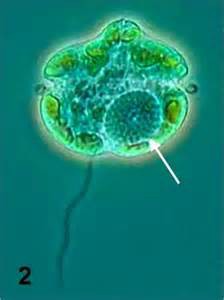
The dinoflagellate Karenia brevis.
Photo: Smithsonian Marine Station-Ft. Pierce FL
The most common red tide dinoflagellate associated with the Gulf of Mexico is Karenia brevis. Karenia blooms typically form offshore and are of little impact to the coastal communities. However when the wind and tides are right these blooms will drift towards shore. When they do fish kills occur and humans have eye and throat irritations. Marine mammals in particular struggle with red tide. As the bloom comes near shore it reaches the bottom of the water column and many of the bottom dwelling fish suffer. Most of the photos of fish I saw in the October 2015 fish kill were bottom dwellers, including many invasive lionfish.
Is there anything we can do to prevent red tides?
Not really… Again, they are naturally occurring event. We may increase the frequency of the events by discharging excessive nutrients into the water from our run-off but they would probably occur anyway. Red tide events are not as common in the panhandle as they are in southwest Florida. The Gulf waters near Charlotte Harbor are shallow, warm, and near the many manicured lawns, gold courses, and the discharge of much of the agriculture in the state. Occasionally blooms formed in that part of the state drift north but this year a bloom formed off of Bay and Gulf counties in early October. The recent storm that passed through probably pushed the bloom inland and to the west. The biggest hazard of humans is eye, throat, and skin irritation. It is quite uncomfortable to be around these blooms. In 1996 a local bloom was concentrated enough that the campground at Ft. Pickens had to be closed. I was in Galveston Texas when I heard about the red tide occurring in the Florida panhandle. As I was leaving Galveston the newspaper reported the closer of all oyster harvesting in Texas due to a red tide generated in the Padre Island area and was moving north. Seems that red tide is covering a large portion of the Gulf coast the last week of October. That said… anything communities can do to reduce nutrient runoff will certain decrease the frequency of red tides.
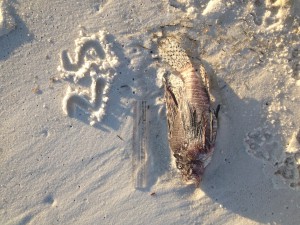
The carcass of the invasive lionfish was part of the October red tide kill.
Photo: Shelly Marshall
The Florida Fish and Wildlife Conservation Commission post red tide updates from around the state on their website and the Escambia County Extension Office post a local water quality update each Friday that has red tide information as well.
FWC
http://myfwc.com/research/redtide/
Escambia County Extension
http://escambia.ifas.ufl.edu
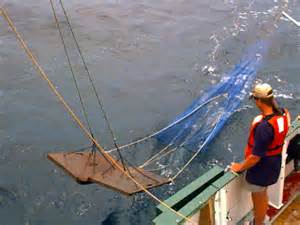
by Rick O'Connor | Oct 31, 2015
So what now?
What lies ahead for the seafood industry in the Florida Panhandle?
Well I will start by saying I do not have a crystal ball… so I truly do not know, but most people plan for the future and many have looked at what COULD happen for Florida seafood.
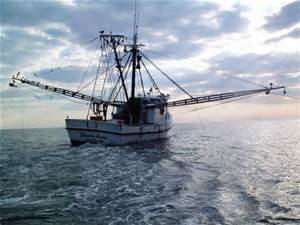
Shrimping.
Photo: NOAA
Will the demand for seafood still be there in the future?
In short… yes
Recent reports indicate that Americans are not consuming the recommended 3-6 ounces of seafood a week. Though many Floridians are not consuming this amount either they are consuming above the national average of 3.5 ounces. Seafood is still important to us. Community fish fries are a part of our culture and will be around. The popularity of sushi and other methods of preparing seafood has increased in recent years. There will be a demand for some seafood products. In the Pensacola area there has been recent interest in buying local seafood. Whether they are willing to pay higher prices than the foreign imports is to be seen but there is still a market for seafood products.
Can the seafood industry meet this demand?
That depends…
Several commercially valuable species have been deemed “overfished”. If the demand for these products increases there could be a problem meeting due to either regulations forbidding the industry to do so, or the numbers of fish available may make it prohibitive. For some species they may become part of a smaller higher paying market. There may be new species introduced that could be marketed and meet the demand, lionfish for example. The demand for this fish is growing but the availability is still low due to method of capture. At the moment the most effective method of harvesting lionfish is by spearing. We do not have enough divers to meet the 500 lbs. of fish / week/ restaurant currently requested. But there is another option to consider… aquaculture.
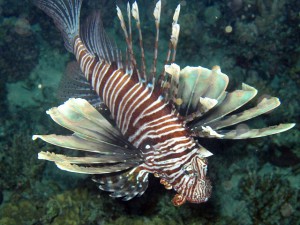
Humans have been growing our food for centuries (agriculture). There are few societies on our planet today they acquire their meat and vegetables solely by hunting and gathering. Aquaculture has also been around for centuries as well, just not in the United States. With the increasing world population, and the need for food along with it, scientists have been working on more efficient ways to produce food for over 100 years. The “green revolution” appeared in the mid 20th century and the impact was huge. The American food machine was churning out products like never before. It did come with a price for the environment around the farms, and there is concern now about the problems with high densities in some livestock operations, but the food is there. Many scientists believe aquaculture will be the method to meet the future seafood demand. Many are not surprised to learn that farm raised fish is common in most supermarkets, but they may be surprised to learn that 80-90% of it is imported from overseas. When we hear “farm raised” we immediately think of Mississippi catfish… which is local right? But in fact much of it is from Asia and Central America.
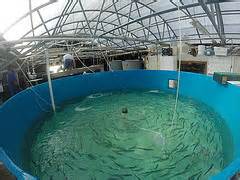
Indoor aquaculture projects are found throughout Florida.
Photo: Florida Sea Grant
Will aquaculture increase in the Florida panhandle and will the public be okay with it?
I do not know.
Many Florida Panhandlers catch their own seafood, and there have been issues between the recreational and commercial fishermen for a few years now. Either way many Panhandlers will seek out fresh local seafood and provide it for their families. Whether they will embrace aquaculture is to be seen.
Either way seafood should be a part of our weekly diet. For many, the post oil spill fear of safety is no longer a concern. There is science that indicates our seafood is safe to eat. The concerns about mercury are real but low consumption of mercury target species (no more than one serving a week) has been deemed safe. For pregnant women (or women trying to become pregnant) this fear has kept them away from all seafood during their pregnancy. A recent study showed that there are important nutrients and vitamins provided in seafood products that are much needed during development and some women are not getting these. The recommendation here is to eat seafood but consume products not high in mercury. There are several agencies who post which species are high in mercury and which are low.
The seafood industry is an important part of panhandle history and culture. Though the industry has fallen on tough times I feel some form of commercial fishing will be around for a few years. We hope you learned something from this series during National Seafood Month and encourage you to ENJOY GULF SEAFOOD!
Additional resources:
Pregnancy
http://americanpregnancy.org/pregnancy-health/mercury-levels-in-fish/
mercury list
http://www.fda.gov/Food/FoodborneIllnessContaminants/Metals/ucm115644.htm
Florida Department of Health – seafood safety
http://www.floridahealth.gov/programs-and-services/prevention/healthy-weight/nutrition/seafood-consumption/fish-advisories-page.html
FWC – mercury
http://myfwc.com/research/saltwater/health/mercury/human-health-advisories/
Florida Sea Grant
http://www.flseagrant.org/seafood/
NOAA-NMFS seafood recommendations
http://www.nmfs.noaa.gov/aquaculture/faqs/faq_seafood_health.html#5how
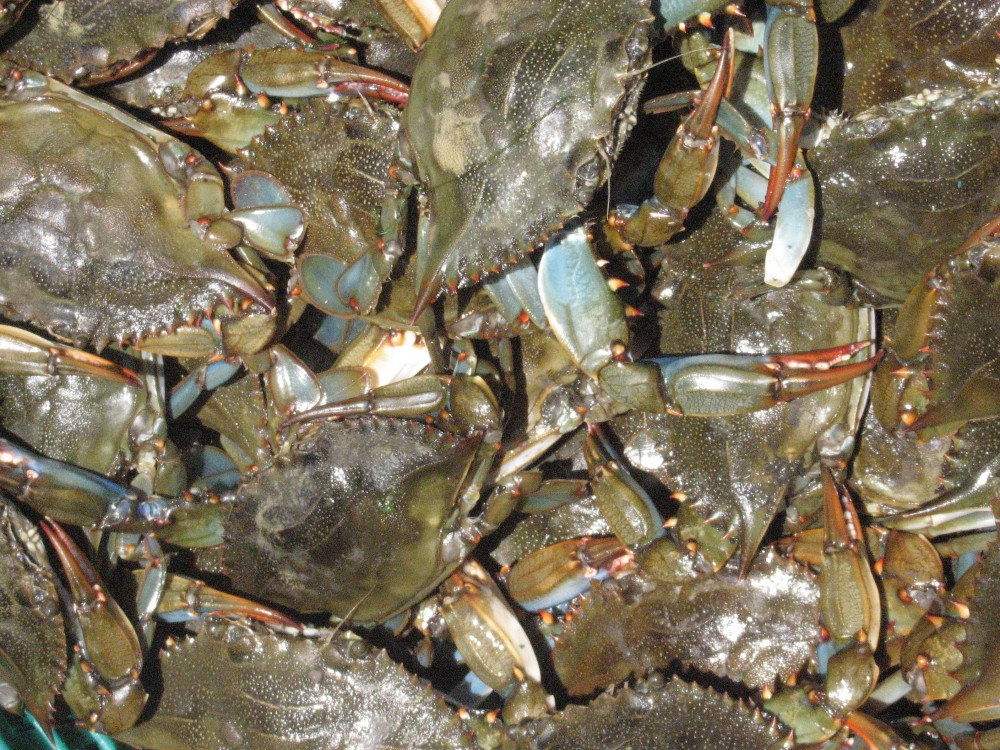
by Rick O'Connor | Oct 23, 2015
Well… we have talked about the “big two”… snapper and shrimp, but there are other popular fin and shellfish harvested from the Gulf of Mexico. This week we look at my personal favorite… blue crab.
Probably like many of you out there, the very first sea creature I ever caught was a blue crab. It was with one of those classic basket traps where you baited it, lowered to the bottom where you could see, waited until a crab came for the bait, and pulled her in… GREAT fun. My parents cooked the crab, saved the shell and dated it. It sat on the cabinet above our breakfast bar for years. It was something I did every summer off the dock of the house we rented on Pensacola Beach… good times.
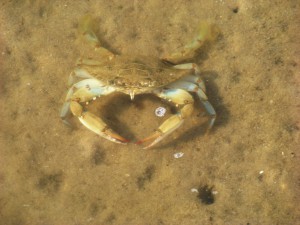
The thin telson beneath this crab indicates it is a male.
Photo: FWC
As I got older we switched from crab traps to hand-held crab nets. We would spend hours searching the grass beds around Gulf Breeze collecting and cleaning these guys. I remember cleaning over 60 of them once until my hands bled, that was about the time I thought I would let the commercial guys do this and I would just buy it from them!
As much fun as I had catching them, I had just as much fun cooking. My wife and I would make deviled crab and one of my personal favorites of hers, crab meat baked on an English muffin with cheese. Man o’ man. What a great creature the crab.
There are about 4500 species of “true crabs” found on our planet and many are valuable as a seafood product. In the Florida Panhandle it is the Blue Crab most seek out. In recent years commercial and recreational crabbers have noticed a decline in their numbers. Landings of blue crab ranged between 8 and 12 million pounds in Florida from 1982-1999 and since 2000 the landings have ranged from 4 to 8 million pounds. Researchers with the Florida Fish and Wildlife Conservation Commission have run several models to determine why the decline in landings has occurred. Though the decline in the Chesapeake may be due to overfishing, the models do not suggest this for Florida. They are not sure why the decline has happened but do have data that support the argument that freshwater discharge during heavy rain events does impact their population in a negative way. Some data suggest the increase in salinity during drought conditions has done the same. Whatever the reason, many would like to see their numbers rebound to the 12 million lb. landings we had just a few years ago.
Blue crabs typically live to be 1-2 years old, though some have been aged to 5 years. Males prefer the less saline waters of the upper estuary and the females can be found throughout the bay. Males reproduce more than once in their lives providing the females with a sack of sperm called a spermatophore. Females mate only once, just after their last molt. Once she has received the spermatophore she heads for the mouth of the bay where the water is more saline, she may enter the Gulf of Mexico searching for the right habitat. When she fertilizers her eggs they remain with her as a mass on her underside; the egg mass resembles a sponge. The larva hatch from this mass and go through several development stages as they re-enter the estuary and begin the cycle again.
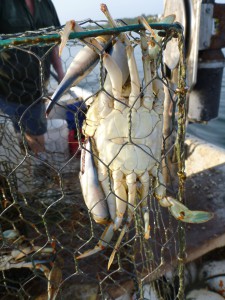
Whatever the reason for their decline, and recent increase in price, these crustaceans remain a Gulf coast favorite and I for one hope they remain around for a long time.

by Rick O'Connor | Oct 17, 2015
If shrimp are king of the shellfish industry, then red snapper are the king of the finfish world. It is arguably the most economically and ecologically important reef fish in the Gulf of Mexico. This fishery began in 1872 with four “snapper smacks” out of Pensacola. By 1890 the fleet had grown to 34 vessels and had extended to other panhandle ports as well as Mobile, AL. They fished local waters for the most part but began to harvest from Campeche MX, where the fish gets its scientific name Lutjanus campechanus. By 1910 the majority of the catch was coming from the Campeche Banks, but by the 1930’s the focus of the fishery was again in U.S. waters. By the mid 20th century a steady decrease in landings began to occur and today the fishery is considered overfished.
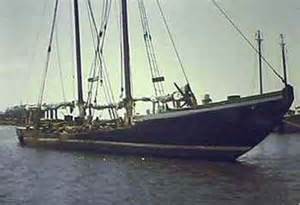
A snapper smack from the 19th century.
Photo: Brown Marine Pensacola
So what do we know about this “king of finfish”? Well, red snapper begin their lives like most fish, as planktonic larva. The larva first appear in northern Gulf around May and are found through November, with numbers peaking from July through September. Though they settle out from the plankton near hard structure, muddy bottom habitats appear to be very important as foraging grounds. Red snapper seem to stay close the hard structures they settle out near, though some movement does occur, particularly with snapper living deeper than 120 feet. They feed on zooplankton when they are young and move to a diet of small reef fish and crustaceans as adults; mantis shrimp are a particular favorite. Red snapper have been reported to live all most 50 years.
The problems with the fishery began in the mid 20th century. Though snapper were listed as overfished by the National Marine Fisheries Service their problems go beyond just overfishing. By-catch in shrimp trawls is a particular problem. Much research and money have been spent to solve this problem. Science has found that young snapper, typically caught in trawls, do not like bright light and experimental trawls with LED lighting have been tested; studies continue.
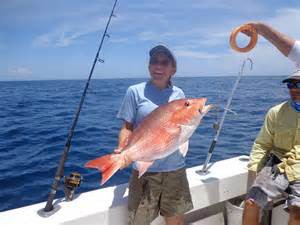
The king of finfish… the red snapper
Photo: Florida Sea Grant
In 1976 the Magnuson-Stevens Fisheries Conservation and Management Act was passed. By 1984 the first size and bag limits were issued and by 1988 the fishery was officially listed as overfished. Success at increasing numbers with the size and bag limits was low due to the shrimping by-catch issue and because many were not surviving the catch and release methods being used to return undersized fish. Studies show that snapper captured at depth experienced pressure problems as they are reeled to the service. This drastic change in pressure caused their swim bladders to expand, or rupture, a process known as barotrauma. Undersized (or over limit) fish had to be released. Those experiencing barotrauma were not surviving. Their expanded swim bladders would cause some to float – typically called “floaters” – and they were easy targets for sharks and dolphins. Others may descend slowly or reach the bottom but are still under stress and, again, were easy targets. Others still survived the release only to have issues with growth and immune function. Several techniques are used by fishing to reduce barotrauma, such as venting, but their success is debated and is currently under study.

One of the many version of descending devices used by fishermen to return snapper to depth.
Photo: Florida Sea Grant
Despite management plans the fishery is still considered overfished. Solving the problem will require plans to deal with the by-catch and barotrauma issues but will also have to address the socio-economic issues of the management itself. Many families depend on this fishery for their livelihood and though a complete ban on the species for a period of time may be beneficial to the fish stock, it may not be practical. Researchers, fisheries managers, and others will continue to work on solving this problem and hopefully the “king of finfish” will be with us for a long time.

















